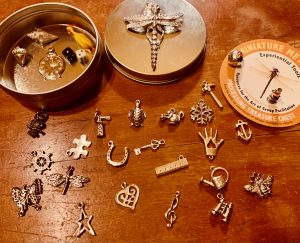Sep 01, 2014 Toolbox, Object, or Miniature Metaphor Charms for Introductions and a “Hook to Engage” or “First Five/Pre-Group Activity”
 Purpose/Focus: active engagement, hook, context setting, discussion or writing prompt, “first five” or “do now,” welcoming ritual, conversation starter, reflection, community building, figurative language, metaphor, emotional connection to learning, differentiation, 21st century skills, creativity/imagination, choice, control and ownership, multiple pathways to learning, group norms
Purpose/Focus: active engagement, hook, context setting, discussion or writing prompt, “first five” or “do now,” welcoming ritual, conversation starter, reflection, community building, figurative language, metaphor, emotional connection to learning, differentiation, 21st century skills, creativity/imagination, choice, control and ownership, multiple pathways to learning, group norms
Materials: a collection of found objects or “Miniature Metaphors”
I use metaphoric objects in much the same way that I use postcards and images. My old toolbox filled with a collection of found objects (i.e., antique keys, old lock, vintage camera,
joke glasses, white out, a ruler) creates a great deal of intrigue in the classroom. I developed the “Miniature Metaphors Kit” (see resources) in response to an Outward Bound instructor who shared that he was looking for small reflective tools he could take into the field.
Facilitation Suggestions
• Using tangible objects is especially effective when introducing the subject of roles or responsibilities in group work or to celebrate strengths or accomplishments:
› As participants enter the room, have them choose an object that represents their role in the project. Or, have them choose the unique perspective or strength they bring to the group.
› Ask participants to join their work groups and share their objects.
This can be a compelling way to help participants address some of the difficulties around communication and teamwork that come up during group projects and turn these challenges into teachable moments around roles and responsibilities, accountability, and establishing positive group norms.
• For language arts classes, the tangible objects can start a reflective writing assignment or discussion about descriptive or figurative language around personal strengths or goals.
The Most Important “Tool in Your Toolbox” Variation:
• Fill your toolbox with a variety of household tools: hammers, tape measures, a whisk, oil can, glue,extension cord, etc.
• As participants enter the room, ask them to choose a tool that represents the most important
“tool” to have in one’s toolkit. Explain that this could be a teaching or learning technique, a philosophical view,attitude, etc. (I find this creates context
for workshops on teaching and group facilitation and jumpstarts thinking on a subject.)
• It can be effective to come back to this tool choice at the end of the training to reflect upon new perspectives gained or lessons learned. I find that the more energy I put into learning about the group and what they do before the program starts, the better the outcome.
A more structured program tailored to that specific group results in the group digging deeper into the activities and getting more to
take home with them.
Reference/Resource: Many variations of object and image reflection activities are described in other books include
A Teachable Moment by Cain et al., Tips & Tools by Stanchfield, as well as The Chiji Guidebook by Cavert and Simpson. You can easily make your own
reflection treasure chest with found objects, old toys, or yard sale items. Miniature Metaphor kits are available at www.experientialtools.com.



No Comments